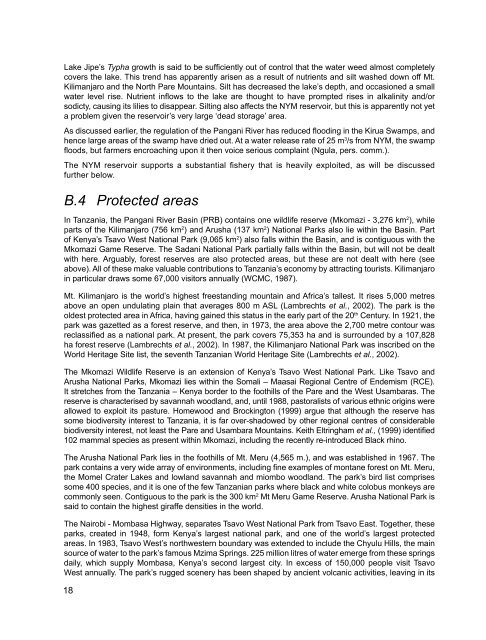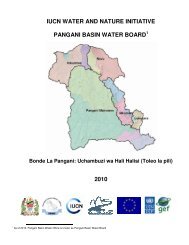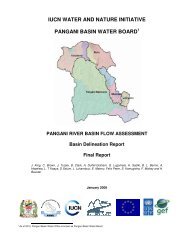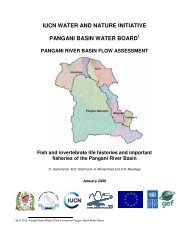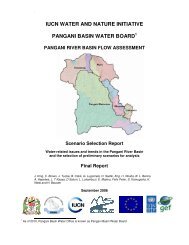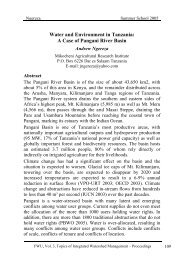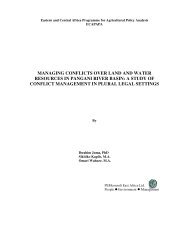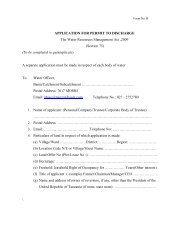PANGANI BASIN WATER BOARD
PANGANI BASIN WATER BOARD
PANGANI BASIN WATER BOARD
Create successful ePaper yourself
Turn your PDF publications into a flip-book with our unique Google optimized e-Paper software.
Lake Jipe’s Typha growth is said to be sufficiently out of control that the water weed almost completely<br />
covers the lake. This trend has apparently arisen as a result of nutrients and silt washed down off Mt.<br />
Kilimanjaro and the North Pare Mountains. Silt has decreased the lake’s depth, and occasioned a small<br />
water level rise. Nutrient inflows to the lake are thought to have prompted rises in alkalinity and/or<br />
sodicty, causing its lilies to disappear. Silting also affects the NYM reservoir, but this is apparently not yet<br />
a problem given the reservoir’s very large ‘dead storage’ area.<br />
As discussed earlier, the regulation of the Pangani River has reduced flooding in the Kirua Swamps, and<br />
hence large areas of the swamp have dried out. At a water release rate of 25 m 3 /s from NYM, the swamp<br />
floods, but farmers encroaching upon it then voice serious complaint (Ngula, pers. comm.).<br />
The NYM reservoir supports a substantial fishery that is heavily exploited, as will be discussed<br />
further below.<br />
B.4 Protected areas<br />
In Tanzania, the Pangani River Basin (PRB) contains one wildlife reserve (Mkomazi - 3,276 km 2 ), while<br />
parts of the Kilimanjaro (756 km 2 ) and Arusha (137 km 2 ) National Parks also lie within the Basin. Part<br />
of Kenya’s Tsavo West National Park (9,065 km 2 ) also falls within the Basin, and is contiguous with the<br />
Mkomazi Game Reserve. The Sadani National Park partially falls within the Basin, but will not be dealt<br />
with here. Arguably, forest reserves are also protected areas, but these are not dealt with here (see<br />
above). All of these make valuable contributions to Tanzania’s economy by attracting tourists. Kilimanjaro<br />
in particular draws some 67,000 visitors annually (WCMC, 1987).<br />
Mt. Kilimanjaro is the world’s highest freestanding mountain and Africa’s tallest. It rises 5,000 metres<br />
above an open undulating plain that averages 800 m ASL (Lambrechts et al., 2002). The park is the<br />
oldest protected area in Africa, having gained this status in the early part of the 20 th Century. In 1921, the<br />
park was gazetted as a forest reserve, and then, in 1973, the area above the 2,700 metre contour was<br />
reclassified as a national park. At present, the park covers 75,353 ha and is surrounded by a 107,828<br />
ha forest reserve (Lambrechts et al., 2002). In 1987, the Kilimanjaro National Park was inscribed on the<br />
World Heritage Site list, the seventh Tanzanian World Heritage Site (Lambrechts et al., 2002).<br />
The Mkomazi Wildlife Reserve is an extension of Kenya’s Tsavo West National Park. Like Tsavo and<br />
Arusha National Parks, Mkomazi lies within the Somali – Maasai Regional Centre of Endemism (RCE).<br />
It stretches from the Tanzania – Kenya border to the foothills of the Pare and the West Usambaras. The<br />
reserve is characterised by savannah woodland, and, until 1988, pastoralists of various ethnic origins were<br />
allowed to exploit its pasture. Homewood and Brockington (1999) argue that although the reserve has<br />
some biodiversity interest to Tanzania, it is far over-shadowed by other regional centres of considerable<br />
biodiversity interest, not least the Pare and Usambara Mountains. Keith Eltringham et al., (1999) identified<br />
102 mammal species as present within Mkomazi, including the recently re-introduced Black rhino.<br />
The Arusha National Park lies in the foothills of Mt. Meru (4,565 m.), and was established in 1967. The<br />
park contains a very wide array of environments, including fine examples of montane forest on Mt. Meru,<br />
the Momel Crater Lakes and lowland savannah and miombo woodland. The park’s bird list comprises<br />
some 400 species, and it is one of the few Tanzanian parks where black and white colobus monkeys are<br />
commonly seen. Contiguous to the park is the 300 km 2 Mt Meru Game Reserve. Arusha National Park is<br />
said to contain the highest giraffe densities in the world.<br />
The Nairobi - Mombasa Highway, separates Tsavo West National Park from Tsavo East. Together, these<br />
parks, created in 1948, form Kenya’s largest national park, and one of the world’s largest protected<br />
areas. In 1983, Tsavo West’s northwestern boundary was extended to include the Chyulu Hills, the main<br />
source of water to the park’s famous Mzima Springs. 225 million litres of water emerge from these springs<br />
daily, which supply Mombasa, Kenya’s second largest city. In excess of 150,000 people visit Tsavo<br />
West annually. The park’s rugged scenery has been shaped by ancient volcanic activities, leaving in its<br />
18


